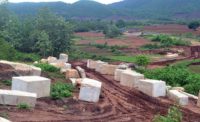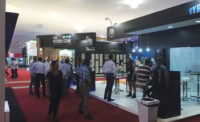With more than 4,850 employees throughout 37 countries, the Cosentino Group has grown by leaps and bounds since it was founded by Francisco “Paco” Martínez-Cosentino in 1979. While the company remains headquartered in Almería, Spain, it also has established Cosentino North America, which is located in Miami, FL. In addition to being a natural stone producer, the Cosentino Group has developed and promotes the brands of Silestone, Dekton and Sensa. At the nucleus of the company is the commitment to people – both internal and its outside customers – as well as to research and development, the environment and the future. Keeping this business philosophy in mind, the Cosentino Group launched an annual conference called the C100, which has significantly grown since it was initially started 22 years ago, to bring everyone in its North American “family” together to learn about new products, share ideas and meet new people. The 22nd edition of the C100 was held in the beautiful tropical location of The Riviera Maya at the start of this year, January 8 to 12. It joined together the brand’s top partners and customers to learn how Cosentino plans to drive innovation in design, manufacturing technology and safety for the surfacing industry in 2020 and in the years to come.
The theme of this year’s C100 was “Committed to the Future. Committed to You.” The five-day event drew its largest crowd to date, with more than 360 individuals representing 164 manufacturing and processing companies from across the U.S. and Canada, as well as representatives from the region’s most important industry associations, including the Natural Stone Institute, the National Kitchen & Bath Association (NKBA), the American Society of Interior Designers (ASID), the International Surface Fabricators Association (ISFA) and the National Association of the Remodeling Industry (NARI).
It became apparent from the start of the convention that the Cosentino Group takes its commitments seriously. The C100 kicked off with an opening address from Martínez-Cosentino where he not only welcomed attendees, but explained they are all a big family that needs to work as a team for the greater success of the future. “We need a good team,” he said. “The Cosentino team encompasses our customers. We have 1,260 people working out there in the U.S. and Canada and another 2,500 to 3,000 fabricators who are promoting our products. That’s why I say it is a joint concern. We need to work together.”
Martínez-Cosentino shared his story with the audience. It wasn’t always easy for him, as he went bankrupt three times. “The businessman lives in a world of risk,” he said. “Business is alive. It’s a road of ups and downs, but you don’t want to be down. We need good leaders that must be an example for their company. Ones that will help those who are weak get up. A company needs to have a soul to create a better world.”
During his speech, Martínez-Cosentino explained that the safety of company employees is very important, and it is also dedicated to developing more ecological friendly products. “We are in the midst of an era of profound change that is challenging us to be competitive, agile and socially conscious,” he said. “From a business perspective, we have to reinforce the integration of environmental measures and values, in addition to further improving our occupational health and safety policies and continuing our digital transformation. In the same way, we have to adapt to the needs of our clients and users. In our case, we must pursue innovation to develop responsible and competitive products in this increasingly global industry, in order to create a sustainable and long-term sector.”
Product development
Those in attendance at this year’s C100 also had the opportunity to learn about new product trends from Valentin Tijeras Garcia, product development manager. “Thank you for trusting us and letting us do what we do and for buying our products,” Garcia started off telling the crowd. Overall, Cosentino’s business grew by 13% in 2019 and there was a 47% increase in Dekton sales alone “[A total of] 350,000 square feet of Dekton was sold in 2019,” he said.
Garcia believes the future looks bright for Dekton in 2020. “We made a white onyx, which is sure to be a super seller,” he said. “Colors are becoming more saturated and starting to resemble stone with veining and patterns.”
In total, there are 19 colors for Dekton. Garcia spoke of the new Liquid Collection, as well as about “Rem,” which is a new texture technology that allows for both smooth and textured effects, and a new X-gloss finish.
For Silestone, a new collection called “Artika” has been introduced. “This is the newest and most advanced Silestone series based on onyx and quartzite,” explained Garcia. “We can get materials really transparent.”
After Garcia’s presentation, large curtains in the auditorium were drawn, creating a dramatic effect and allowing attendees to view the latest collections of both Silestone and Dekton.
Networking opportunities
While there was several days of presentations at the C100, there was also plenty of time for mingling with industry members and to enjoy the outdoors. In addition to Cosentino’s customers, there were also representatives from many leading manufacturers of machinery, tooling and accessories in the stone and surface industries who were sponsors of the event. Throughout the conference, attendees were given opportunities to talk with the sponsors to learn about their products.
Additionally, there were social activities scheduled such as the beach volleyball tournament, which was sponsored by GranQuartz, a golf outing, and dinners and entertainment. All of the scheduled events provided a platform for attendees to get to know one another and hopefully take away something valuable from the experience.
|
Eduardo Cosentino During the C100 conference, Stone World’s editor, Jennifer Richinelli, had the opportunity to sit down with Eduardo Cosentino, president of Cosentino North America, which is based in Miami, FL. Cosentino, who recently celebrated his 10th anniversary as the head of Cosentino North America, shared his thoughts on the conference itself, the company’s business philosophy and infrastructure, as well as on the importance of building relationships with fabricators, distributors and the architecture and design community to make them feel a part of the Cosentino “family.” What’s new with Cosentino North America?EC: We have an exciting year in 2020. Every year we try to bring a new product/innovation to the marketplace. Here at C100, we are introducing to our main customers the new colors and designs that we are bringing to the market this year and what we are working on for the next couple of years. At the same time, we are not only talking about colors and design, but we try to provide to our customers new ways to do business. Listening to what your father said in his opening presentation, Cosentino is about everyone being a team – including your customers, such as the fabricators and distributors. Do you also believe this contributes to the success of the company?EC: Yes. If you believe that only by yourself you will have success, then you are wrong. You need the support of your suppliers and you need to work together with your customers to make sure you deliver to them what they need. If you put all of this together, there is no doubt you will have big success in the coming years. Your design centers are popping up everywhere. There is even one in New Jersey near where I live that I pass often. How many do you have now, and when selecting a new location for one, what are some points/factors that are considered?EC: We have different ways that we go to the market. We have what we call Cosentino Centers that are showrooms together with distribution warehouses where we keep our inventory. We also have Cosentino Cities, which are big showrooms in the center of the big cities in the world. We try to show the different applications that we can build with our products. At the same time, we try to facilitate access not only to architects and designers, but also to consumers. They can leave the experience knowing about a different application that we have and a new product that we have available. Something that we are introducing right now is everything related with a digital transformation. It’s very difficult in a 3,000- or 4,000-square-foot showroom to show everything that we have. For that reason, with new technology that we are implementing in the design centers and city showrooms, we can show to all these potential customers all that we have – not only what they can do now, but also we can help them imagine projects they can be working on in the future. That’s smart. Even sitting in the opening presentation this morning, you can see how with the large screens and music you can really draw people in. It’s amazing.EC: Exactly. Today, we can play with the technology and show what they can build. They not only can have our product, but they can see how they can use it with other products to build something for the future. Obviously, fabricators are an important part of your family too. How does that work? Do they become certified?EC: Certified is not the right word. In North America, we have 7,000 fabricators who work with Cosentino today. We sell to all of them, but we have different programs. We try to reward customers who are loyal to Cosentino, and of course, Cosentino with them. Ones who know how to fabricate the right way. These loyal fabricators work together with us to build a brand and to build a market. One program is called “WE.” That is for loyal fabricators to us. We also have “Dekton Ambassador,” which is more of a certification process. People that know how to fabricate the product, and at the same time, people who are helping us to push the product onto the marketplace. So the idea is that with the fabricators being educated they can then pass along information to their customers and educate them on the product?EC: Yes. When you introduce a new product to the marketplace, like Dekton, which we introduced in 2013, there are some challenges — like anyone who introduces a new product can encounter. During that time, we learned about what is the best way to fabricate the product, manipulate the product, etc. We try to share with all of the fabricators what is the best way to work with Dekton so they have a favorable business with Dekton. And for that reason, we created the certification for the Dekton Ambassador fabricator to make sure they can deliver to their customers. I can see from when it first came out until now, when I go into fabrication shops, more and more are cutting Dekton.EC: It is something that is growing. Like I said, we had a lot of challenges in the beginning, but today, Dekton is a reality. If you want to be the leader than you have to do something different and take the risk. Lastly, what was the inspiration for the C100? What is the main message you want to communicate to your customers who attend?EC: For me, there are several messages. First of all, like we showed in our presentations this morning, we want to help and work to have a better world — for children, the children of our children, for the future. I think Cosentino can help to build a nice future. The second thing is that we are here to make business and to be profitable. We want to show our customers the different things they can do for their business. For me, the most important thing in this conference is creating relationships. In my opinion, that is the best way to build a business. This conference gave us the opportunity to create relationships with our customers. It gives our customers the opportunity to create relationships with different fabricators within the industry. I hope during the conference they are able to come up with new ideas for their businesses, and we can start the year in a positive way for a positive future. For me, the best takeaway from this conference is building relationships. |
|
Francisco “Paco” Martínez-Cosentino From its start in 1979, Cosentino Group has continued to evolve to the innovative industry leader it is today. At its roots, the company is a natural stone producer, but it has expanded to owning several global brands of quartz and sintered stone products. At the heart of the company is Francisco Martínez-Cosentino, more commonly known as Paco. The founder and chairman of Cosentino Group gave an opening address to those attending the C100 conference, in which he stressed the importance of team work and continual research and development to maintain a profitable business. Through all the years since Cosentino started, it continues to be a leader in research and product development. What do you believe are the contributing factors to this success?PC: First of all, we have a great team. We also have never launched a product and then just crossed our arms. You might have a good product and you have a moment and you catch it, but then it disappears. So you can’t rest. And if you think of the first product that I had, which was Blanco Macael marble, we would be totally dead right now if we just stayed with that product and not found others. That makes sense. I see you are always thinking. Through all your years of business, what are your proudest accomplishments?PC: Working with a lot of people I have felt that way. And to be honest with you, what makes me most proud is creating employment. When you have local resources and you are a business owner, you have to strive to create more richness, otherwise the whole local area becomes a desert. You have to create business. And to me, this is a deep personal satisfaction. I want to thank you for inviting me to the C100. I have learned a great deal about Cosentino and I enjoyed your welcome speech. It has become very clear through all of the talks and your employees that I have met that you all care about each other and it is a team-working environment. Have you always had this business philosophy about teamwork or has it evolved over the years?PC: I always thought that the “team” was an important thing, but I would be lying to you if I said I realized the huge importance of this from the beginning. You have done a good job in realizing this and it shows in all of your employees that I have encountered, including your son, Eduardo.PC: Thank you. What is your favorite part of C100? What does it mean to you?PC: To me, one of the most important things is to find out what is going on in the market. I want to listen to the people who are out on the street. To sum it up, I come here to learn. |











